Ecuador · Hawaii · Leisure Travel · Mexico · North America · Regions · South America · Speciality Travel · USA
5 of the greatest manta ray diving sites in the Americas
Those people who have dived alongside a giant manta ray — witnessing its gentle, elegant and avian-like motions — describe this creature’s actions as the closest thing to flying.
 A few years ago, contacts with these mysterious creatures were practically unknown on the coasts of Asian countries. In fact, these fish were about to disappear due to fishing, as people sought their gills for traditional medicines.
Ecuador, though, has taken efforts to protect these gentle giants. Being the first country to prohibit their fishing, it’s quite common to see manta rays in this South American country, especially between June and October. This is when Giant manta rays arrive off the Ecuadorian Pacific coast to mate and feed on plankton supplied by the cold Humboldt current.
A few years ago, contacts with these mysterious creatures were practically unknown on the coasts of Asian countries. In fact, these fish were about to disappear due to fishing, as people sought their gills for traditional medicines.
Ecuador, though, has taken efforts to protect these gentle giants. Being the first country to prohibit their fishing, it’s quite common to see manta rays in this South American country, especially between June and October. This is when Giant manta rays arrive off the Ecuadorian Pacific coast to mate and feed on plankton supplied by the cold Humboldt current.
 Spotting members of this beautiful migratory species on the seafloor as they swim among turtles, moray eels, and multicolored fish is one of the most intense and exciting experiences for a diver. It can also be overwhelming; after all, the Giant manta ray is one of the largest fish in the world, measuring up to eight meters long.
In Ecuador, a country that currently has the largest number of Giant manta rays in the world, there are three sites that are especially privileged for up-close observations and diving with these magnificent creatures. These sites are Cape Marshall, in the Galapagos Islands, as well as Machalilla National Park and Ayangue beach, both on mainland Ecuador’s Pacific coast.
In these three areas, diving lovers can experience the thrill of seeing a Giant manta ray slowly approaching them, perhaps with the same curiosity and fascination that we humans have when encountering them.
1. Cape Marshall, Galapagos Islands
The Galapagos Islands, declared by UNESCO as an official “World Heritage Site,” is the second largest marine reserve in the world. Covering 133,000 square kilometers, it’s one of the richest and most biodiverse marine ecosystems on the planet. For travel lovers, this paradise is home to 19 species of seabirds, 30 species of migratory birds, and some 20,000 sea lions. There are also endemic species such as the Marine iguana, Galapagos penguins, Flightless cormorants, and the Galapagos albatross. In addition, the archipelago is the refuge of vulnerable and endangered marine species such as the Green turtle, whale sharks, Galapagos sharks and, of course, the Giant manta ray.
In many dive sites in the Galapagos Islands, the search for Giant manta rays can be an effort – often an unsuccessful one. But at Cape Marshall, the sighting of these beautiful species is almost guaranteed.
A huge aquarium, the Galapagos Islands is an especially advantaged place for viewing Giant manta rays and diving with them. Adventurers who arrive in this paradisiacal archipelago can travel to the northeast coast of sprawling Isabela Island to find Cape Marshall. Here, the water’s depth exceeds 40 meters (130 feet) and visibility varies between six and twenty-one meters (20-70 feet), depending on the time of year. The current varies between moderate and strong, while within coral walls are colorful fish, barracudas, sharks, iguanas, and sea lions.
2. Machalilla National Park, Ecuador’s Pacific Coast
Famous Machalilla National Park, located on Ecuador’s coast, is recognized as one of the most biodiverse reserves in the world. Along with the terrestrial part of the park, this reserve includes an extensive marine area that receives the influence of the Humboldt current. By providing an abundance of plankton, this current attracts Giant manta rays to make it an excellent site for diving.
Spotting members of this beautiful migratory species on the seafloor as they swim among turtles, moray eels, and multicolored fish is one of the most intense and exciting experiences for a diver. It can also be overwhelming; after all, the Giant manta ray is one of the largest fish in the world, measuring up to eight meters long.
In Ecuador, a country that currently has the largest number of Giant manta rays in the world, there are three sites that are especially privileged for up-close observations and diving with these magnificent creatures. These sites are Cape Marshall, in the Galapagos Islands, as well as Machalilla National Park and Ayangue beach, both on mainland Ecuador’s Pacific coast.
In these three areas, diving lovers can experience the thrill of seeing a Giant manta ray slowly approaching them, perhaps with the same curiosity and fascination that we humans have when encountering them.
1. Cape Marshall, Galapagos Islands
The Galapagos Islands, declared by UNESCO as an official “World Heritage Site,” is the second largest marine reserve in the world. Covering 133,000 square kilometers, it’s one of the richest and most biodiverse marine ecosystems on the planet. For travel lovers, this paradise is home to 19 species of seabirds, 30 species of migratory birds, and some 20,000 sea lions. There are also endemic species such as the Marine iguana, Galapagos penguins, Flightless cormorants, and the Galapagos albatross. In addition, the archipelago is the refuge of vulnerable and endangered marine species such as the Green turtle, whale sharks, Galapagos sharks and, of course, the Giant manta ray.
In many dive sites in the Galapagos Islands, the search for Giant manta rays can be an effort – often an unsuccessful one. But at Cape Marshall, the sighting of these beautiful species is almost guaranteed.
A huge aquarium, the Galapagos Islands is an especially advantaged place for viewing Giant manta rays and diving with them. Adventurers who arrive in this paradisiacal archipelago can travel to the northeast coast of sprawling Isabela Island to find Cape Marshall. Here, the water’s depth exceeds 40 meters (130 feet) and visibility varies between six and twenty-one meters (20-70 feet), depending on the time of year. The current varies between moderate and strong, while within coral walls are colorful fish, barracudas, sharks, iguanas, and sea lions.
2. Machalilla National Park, Ecuador’s Pacific Coast
Famous Machalilla National Park, located on Ecuador’s coast, is recognized as one of the most biodiverse reserves in the world. Along with the terrestrial part of the park, this reserve includes an extensive marine area that receives the influence of the Humboldt current. By providing an abundance of plankton, this current attracts Giant manta rays to make it an excellent site for diving.
 In Machalilla National Park, amateurs and professionals alike can find more than twenty diving sites. Not only will you find manta rays in these locations, but you will also be dazzled by the beauty of coral reefs and species such as sea turtles, tropical fish, crustaceans, and whales – as whale watching is another attraction in this area.
At this reserve, visitors can also discover exotic, almost unexplored beaches and two magical islands: Salango and Isla de la Plata. Around the latter island is one of the largest colonies of Giant manta rays in the area, with more than 2,000 specimens arriving every year.
In Machalilla National Park, amateurs and professionals alike can find more than twenty diving sites. Not only will you find manta rays in these locations, but you will also be dazzled by the beauty of coral reefs and species such as sea turtles, tropical fish, crustaceans, and whales – as whale watching is another attraction in this area.
At this reserve, visitors can also discover exotic, almost unexplored beaches and two magical islands: Salango and Isla de la Plata. Around the latter island is one of the largest colonies of Giant manta rays in the area, with more than 2,000 specimens arriving every year.
 Other important attractions at Machalilla Park National are its famous Frailes Beach, the Agua Blanca museum of aboriginal cultures, and the small and picturesque village of Puerto Lopez. Before or after diving at the fantastic sites provided by Machalilla Park, adventurous travelers can also walk along extraordinary ecological forests trails to see some of the more than 270 species of birds, various species of monkeys, tigrillos, jaguars, peccaries, deer, anteaters, sloths and more.
3. Ayangue, Ecuador’s Pacific Coast
Ayangue, a small fishing village surrounded by beautiful beaches of clear sand and turquoise waters, is another starting point for a Giant manta ray diving tour. This small bay, increasingly popular with tourists, is part of the so-called “Route of the Sun,” a stretch that consists of the best landscapes, handicrafts, natural landscapes, history, archeology, and cuisine of Ecuador’s coastal provinces.
Around Ayangue, the area’s principal wealth is that found at the bottom of the sea, which is why sports and diving enthusiasts find this an ideal place for experiencing intense adventure. The calm and crystal-clear waters of this area allow you to dive among lobsters, turtles, colorful tropical fish, sea horses and, of course, fantastic Giant manta rays. In the waters of Ayangue, divers can experience the thrill of seeing these huge creatures up close, only to find that they are tame and intelligent (they are said to have the largest brain among all species of sharks and rays).
Other important attractions at Machalilla Park National are its famous Frailes Beach, the Agua Blanca museum of aboriginal cultures, and the small and picturesque village of Puerto Lopez. Before or after diving at the fantastic sites provided by Machalilla Park, adventurous travelers can also walk along extraordinary ecological forests trails to see some of the more than 270 species of birds, various species of monkeys, tigrillos, jaguars, peccaries, deer, anteaters, sloths and more.
3. Ayangue, Ecuador’s Pacific Coast
Ayangue, a small fishing village surrounded by beautiful beaches of clear sand and turquoise waters, is another starting point for a Giant manta ray diving tour. This small bay, increasingly popular with tourists, is part of the so-called “Route of the Sun,” a stretch that consists of the best landscapes, handicrafts, natural landscapes, history, archeology, and cuisine of Ecuador’s coastal provinces.
Around Ayangue, the area’s principal wealth is that found at the bottom of the sea, which is why sports and diving enthusiasts find this an ideal place for experiencing intense adventure. The calm and crystal-clear waters of this area allow you to dive among lobsters, turtles, colorful tropical fish, sea horses and, of course, fantastic Giant manta rays. In the waters of Ayangue, divers can experience the thrill of seeing these huge creatures up close, only to find that they are tame and intelligent (they are said to have the largest brain among all species of sharks and rays).
 In this area of the Ecuadorian coast, there are other attractions. One of them is the underwater “Christ of the Waters” statue. Standing 3-meters high, this submerged work of art was donated to the park in 2011 by a Colombian artist who learned to dive in Ayangue. Near it, is another area attraction: a sunken ship resting about 16 meters beneath the surface. This boat was given to the park by the Oceanographic Institute of the Ecuadorian Navy. Located off a small island known as “El Pelado,” about 15 minutes from Ayangue, both of these donations have become mysterious underwater attractions.
Take note of these three areas and remember that the adventure of witnessing and interacting with Giant manta rays on a diving excursion is unforgettable. Of course, it’s best to plan your trip with experts who are thoroughly knowledgeable of local operations and can ensure that you have a safe and completely satisfying trip.
4. Island of Kona, Hawaii
While diving with giant manta rays is already an exciting experience, nighttime dive near these enormous-yet-docile beings can be the thrill of a lifetime. Some people have described it as “something like being in outer space.” In fact, the US Travel Channel described this activity as “one of the 10 things you must do in life.”
At the Kona dive site, in Hawaii, lovers of underwater adventure can see giant manta rays close up, as these fish are attracted by the boats’ diving lights and by the presence of plankton. These are kind and curious beasts that, unlike other species, have no teeth, barbs or stingers. The thrill of seeing them approach and witnessing them on the seabed, illuminated by the diving lights, are the objectives of these nocturnal dives.
Diving off Kona can be done all year round, but the best time is between April and October, when one can experience many sightings, especially on moonless nights when the water is calmer.
5. Revillagigedo archipelago, Mexico
The fifth and final dive site in the Americas is off the west of the Mexican coast near Socorro Island. This site is part of the Revillagigedo archipelago, recently named a Mexican national park. Here, especially in the winter, divers can find a giant manta ray species known as the “black diamond,” so named for their color and shape. It’s estimated that 50 percent of the tourists who visit the archipelago come to see these manta rays and to swim with them. Indeed, it has been calculated that each of these rays brings no less than a million dollars into the local tourism economy over their long, 50-year lifetimes.
In this area of the Ecuadorian coast, there are other attractions. One of them is the underwater “Christ of the Waters” statue. Standing 3-meters high, this submerged work of art was donated to the park in 2011 by a Colombian artist who learned to dive in Ayangue. Near it, is another area attraction: a sunken ship resting about 16 meters beneath the surface. This boat was given to the park by the Oceanographic Institute of the Ecuadorian Navy. Located off a small island known as “El Pelado,” about 15 minutes from Ayangue, both of these donations have become mysterious underwater attractions.
Take note of these three areas and remember that the adventure of witnessing and interacting with Giant manta rays on a diving excursion is unforgettable. Of course, it’s best to plan your trip with experts who are thoroughly knowledgeable of local operations and can ensure that you have a safe and completely satisfying trip.
4. Island of Kona, Hawaii
While diving with giant manta rays is already an exciting experience, nighttime dive near these enormous-yet-docile beings can be the thrill of a lifetime. Some people have described it as “something like being in outer space.” In fact, the US Travel Channel described this activity as “one of the 10 things you must do in life.”
At the Kona dive site, in Hawaii, lovers of underwater adventure can see giant manta rays close up, as these fish are attracted by the boats’ diving lights and by the presence of plankton. These are kind and curious beasts that, unlike other species, have no teeth, barbs or stingers. The thrill of seeing them approach and witnessing them on the seabed, illuminated by the diving lights, are the objectives of these nocturnal dives.
Diving off Kona can be done all year round, but the best time is between April and October, when one can experience many sightings, especially on moonless nights when the water is calmer.
5. Revillagigedo archipelago, Mexico
The fifth and final dive site in the Americas is off the west of the Mexican coast near Socorro Island. This site is part of the Revillagigedo archipelago, recently named a Mexican national park. Here, especially in the winter, divers can find a giant manta ray species known as the “black diamond,” so named for their color and shape. It’s estimated that 50 percent of the tourists who visit the archipelago come to see these manta rays and to swim with them. Indeed, it has been calculated that each of these rays brings no less than a million dollars into the local tourism economy over their long, 50-year lifetimes.
 This species’ flattened bodies, as well as their black and with white spots, are what makes this species so attractive. Divers find them mostly near the coast and reefs since they feed on small fish and plankton. It’s said that this mysterious species of giant manta rays, which can also be seen off the Mexican coasts of Nayarit or Jalisco, are very intelligent. They are even said to exhibit a certain degree of empathy with divers. When they feel the bubbles coming from the oxygen tanks, they become more at ease and act “friendlier” with their human visitors.
On dives in the Revillagigedo Archipelago, you can also see other large fish and animals such as sharks, dolphins, and humpback whales (especially from January to March). All this has earned the archipelago the distinction of being one of the best diving destinations on the planet. The best season is from November to May, as the weather is milder during this period.
Alfonso Tandazo is President and CEO at Surtrek Tour Operator. Surtrek Tour Operator is a well-established firm, specializing in custom-designed luxury tours in Ecuador, the Galapagos and throughout the rest of South America.
If you would like to be a guest blogger on A Luxury Travel Blog in order to raise your profile, please contact us.
This species’ flattened bodies, as well as their black and with white spots, are what makes this species so attractive. Divers find them mostly near the coast and reefs since they feed on small fish and plankton. It’s said that this mysterious species of giant manta rays, which can also be seen off the Mexican coasts of Nayarit or Jalisco, are very intelligent. They are even said to exhibit a certain degree of empathy with divers. When they feel the bubbles coming from the oxygen tanks, they become more at ease and act “friendlier” with their human visitors.
On dives in the Revillagigedo Archipelago, you can also see other large fish and animals such as sharks, dolphins, and humpback whales (especially from January to March). All this has earned the archipelago the distinction of being one of the best diving destinations on the planet. The best season is from November to May, as the weather is milder during this period.
Alfonso Tandazo is President and CEO at Surtrek Tour Operator. Surtrek Tour Operator is a well-established firm, specializing in custom-designed luxury tours in Ecuador, the Galapagos and throughout the rest of South America.
If you would like to be a guest blogger on A Luxury Travel Blog in order to raise your profile, please contact us.
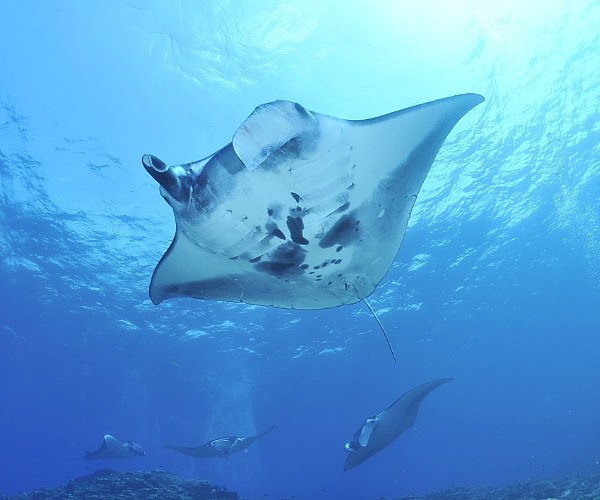 A few years ago, contacts with these mysterious creatures were practically unknown on the coasts of Asian countries. In fact, these fish were about to disappear due to fishing, as people sought their gills for traditional medicines.
Ecuador, though, has taken efforts to protect these gentle giants. Being the first country to prohibit their fishing, it’s quite common to see manta rays in this South American country, especially between June and October. This is when Giant manta rays arrive off the Ecuadorian Pacific coast to mate and feed on plankton supplied by the cold Humboldt current.
A few years ago, contacts with these mysterious creatures were practically unknown on the coasts of Asian countries. In fact, these fish were about to disappear due to fishing, as people sought their gills for traditional medicines.
Ecuador, though, has taken efforts to protect these gentle giants. Being the first country to prohibit their fishing, it’s quite common to see manta rays in this South American country, especially between June and October. This is when Giant manta rays arrive off the Ecuadorian Pacific coast to mate and feed on plankton supplied by the cold Humboldt current.
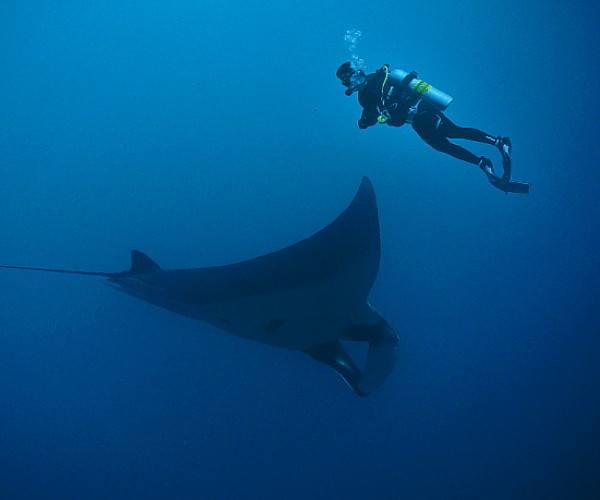 Spotting members of this beautiful migratory species on the seafloor as they swim among turtles, moray eels, and multicolored fish is one of the most intense and exciting experiences for a diver. It can also be overwhelming; after all, the Giant manta ray is one of the largest fish in the world, measuring up to eight meters long.
In Ecuador, a country that currently has the largest number of Giant manta rays in the world, there are three sites that are especially privileged for up-close observations and diving with these magnificent creatures. These sites are Cape Marshall, in the Galapagos Islands, as well as Machalilla National Park and Ayangue beach, both on mainland Ecuador’s Pacific coast.
In these three areas, diving lovers can experience the thrill of seeing a Giant manta ray slowly approaching them, perhaps with the same curiosity and fascination that we humans have when encountering them.
1. Cape Marshall, Galapagos Islands
The Galapagos Islands, declared by UNESCO as an official “World Heritage Site,” is the second largest marine reserve in the world. Covering 133,000 square kilometers, it’s one of the richest and most biodiverse marine ecosystems on the planet. For travel lovers, this paradise is home to 19 species of seabirds, 30 species of migratory birds, and some 20,000 sea lions. There are also endemic species such as the Marine iguana, Galapagos penguins, Flightless cormorants, and the Galapagos albatross. In addition, the archipelago is the refuge of vulnerable and endangered marine species such as the Green turtle, whale sharks, Galapagos sharks and, of course, the Giant manta ray.
In many dive sites in the Galapagos Islands, the search for Giant manta rays can be an effort – often an unsuccessful one. But at Cape Marshall, the sighting of these beautiful species is almost guaranteed.
A huge aquarium, the Galapagos Islands is an especially advantaged place for viewing Giant manta rays and diving with them. Adventurers who arrive in this paradisiacal archipelago can travel to the northeast coast of sprawling Isabela Island to find Cape Marshall. Here, the water’s depth exceeds 40 meters (130 feet) and visibility varies between six and twenty-one meters (20-70 feet), depending on the time of year. The current varies between moderate and strong, while within coral walls are colorful fish, barracudas, sharks, iguanas, and sea lions.
2. Machalilla National Park, Ecuador’s Pacific Coast
Famous Machalilla National Park, located on Ecuador’s coast, is recognized as one of the most biodiverse reserves in the world. Along with the terrestrial part of the park, this reserve includes an extensive marine area that receives the influence of the Humboldt current. By providing an abundance of plankton, this current attracts Giant manta rays to make it an excellent site for diving.
Spotting members of this beautiful migratory species on the seafloor as they swim among turtles, moray eels, and multicolored fish is one of the most intense and exciting experiences for a diver. It can also be overwhelming; after all, the Giant manta ray is one of the largest fish in the world, measuring up to eight meters long.
In Ecuador, a country that currently has the largest number of Giant manta rays in the world, there are three sites that are especially privileged for up-close observations and diving with these magnificent creatures. These sites are Cape Marshall, in the Galapagos Islands, as well as Machalilla National Park and Ayangue beach, both on mainland Ecuador’s Pacific coast.
In these three areas, diving lovers can experience the thrill of seeing a Giant manta ray slowly approaching them, perhaps with the same curiosity and fascination that we humans have when encountering them.
1. Cape Marshall, Galapagos Islands
The Galapagos Islands, declared by UNESCO as an official “World Heritage Site,” is the second largest marine reserve in the world. Covering 133,000 square kilometers, it’s one of the richest and most biodiverse marine ecosystems on the planet. For travel lovers, this paradise is home to 19 species of seabirds, 30 species of migratory birds, and some 20,000 sea lions. There are also endemic species such as the Marine iguana, Galapagos penguins, Flightless cormorants, and the Galapagos albatross. In addition, the archipelago is the refuge of vulnerable and endangered marine species such as the Green turtle, whale sharks, Galapagos sharks and, of course, the Giant manta ray.
In many dive sites in the Galapagos Islands, the search for Giant manta rays can be an effort – often an unsuccessful one. But at Cape Marshall, the sighting of these beautiful species is almost guaranteed.
A huge aquarium, the Galapagos Islands is an especially advantaged place for viewing Giant manta rays and diving with them. Adventurers who arrive in this paradisiacal archipelago can travel to the northeast coast of sprawling Isabela Island to find Cape Marshall. Here, the water’s depth exceeds 40 meters (130 feet) and visibility varies between six and twenty-one meters (20-70 feet), depending on the time of year. The current varies between moderate and strong, while within coral walls are colorful fish, barracudas, sharks, iguanas, and sea lions.
2. Machalilla National Park, Ecuador’s Pacific Coast
Famous Machalilla National Park, located on Ecuador’s coast, is recognized as one of the most biodiverse reserves in the world. Along with the terrestrial part of the park, this reserve includes an extensive marine area that receives the influence of the Humboldt current. By providing an abundance of plankton, this current attracts Giant manta rays to make it an excellent site for diving.
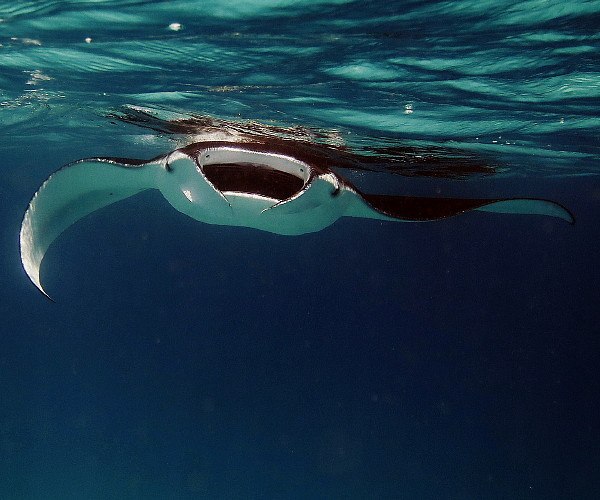 In Machalilla National Park, amateurs and professionals alike can find more than twenty diving sites. Not only will you find manta rays in these locations, but you will also be dazzled by the beauty of coral reefs and species such as sea turtles, tropical fish, crustaceans, and whales – as whale watching is another attraction in this area.
At this reserve, visitors can also discover exotic, almost unexplored beaches and two magical islands: Salango and Isla de la Plata. Around the latter island is one of the largest colonies of Giant manta rays in the area, with more than 2,000 specimens arriving every year.
In Machalilla National Park, amateurs and professionals alike can find more than twenty diving sites. Not only will you find manta rays in these locations, but you will also be dazzled by the beauty of coral reefs and species such as sea turtles, tropical fish, crustaceans, and whales – as whale watching is another attraction in this area.
At this reserve, visitors can also discover exotic, almost unexplored beaches and two magical islands: Salango and Isla de la Plata. Around the latter island is one of the largest colonies of Giant manta rays in the area, with more than 2,000 specimens arriving every year.
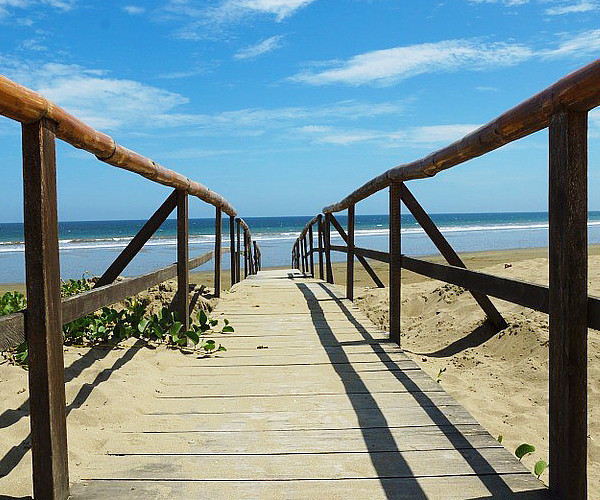 Other important attractions at Machalilla Park National are its famous Frailes Beach, the Agua Blanca museum of aboriginal cultures, and the small and picturesque village of Puerto Lopez. Before or after diving at the fantastic sites provided by Machalilla Park, adventurous travelers can also walk along extraordinary ecological forests trails to see some of the more than 270 species of birds, various species of monkeys, tigrillos, jaguars, peccaries, deer, anteaters, sloths and more.
3. Ayangue, Ecuador’s Pacific Coast
Ayangue, a small fishing village surrounded by beautiful beaches of clear sand and turquoise waters, is another starting point for a Giant manta ray diving tour. This small bay, increasingly popular with tourists, is part of the so-called “Route of the Sun,” a stretch that consists of the best landscapes, handicrafts, natural landscapes, history, archeology, and cuisine of Ecuador’s coastal provinces.
Around Ayangue, the area’s principal wealth is that found at the bottom of the sea, which is why sports and diving enthusiasts find this an ideal place for experiencing intense adventure. The calm and crystal-clear waters of this area allow you to dive among lobsters, turtles, colorful tropical fish, sea horses and, of course, fantastic Giant manta rays. In the waters of Ayangue, divers can experience the thrill of seeing these huge creatures up close, only to find that they are tame and intelligent (they are said to have the largest brain among all species of sharks and rays).
Other important attractions at Machalilla Park National are its famous Frailes Beach, the Agua Blanca museum of aboriginal cultures, and the small and picturesque village of Puerto Lopez. Before or after diving at the fantastic sites provided by Machalilla Park, adventurous travelers can also walk along extraordinary ecological forests trails to see some of the more than 270 species of birds, various species of monkeys, tigrillos, jaguars, peccaries, deer, anteaters, sloths and more.
3. Ayangue, Ecuador’s Pacific Coast
Ayangue, a small fishing village surrounded by beautiful beaches of clear sand and turquoise waters, is another starting point for a Giant manta ray diving tour. This small bay, increasingly popular with tourists, is part of the so-called “Route of the Sun,” a stretch that consists of the best landscapes, handicrafts, natural landscapes, history, archeology, and cuisine of Ecuador’s coastal provinces.
Around Ayangue, the area’s principal wealth is that found at the bottom of the sea, which is why sports and diving enthusiasts find this an ideal place for experiencing intense adventure. The calm and crystal-clear waters of this area allow you to dive among lobsters, turtles, colorful tropical fish, sea horses and, of course, fantastic Giant manta rays. In the waters of Ayangue, divers can experience the thrill of seeing these huge creatures up close, only to find that they are tame and intelligent (they are said to have the largest brain among all species of sharks and rays).
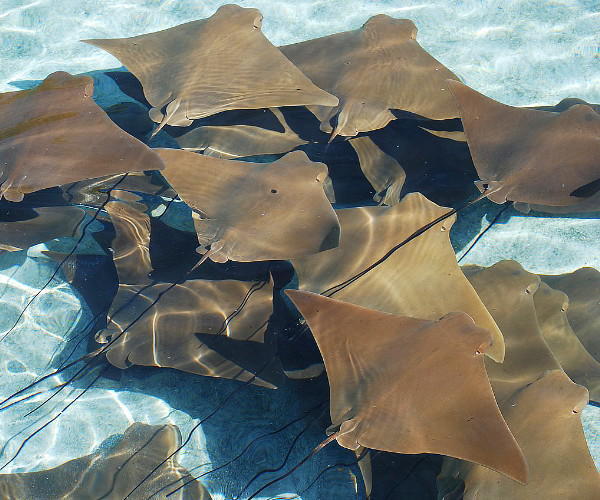 In this area of the Ecuadorian coast, there are other attractions. One of them is the underwater “Christ of the Waters” statue. Standing 3-meters high, this submerged work of art was donated to the park in 2011 by a Colombian artist who learned to dive in Ayangue. Near it, is another area attraction: a sunken ship resting about 16 meters beneath the surface. This boat was given to the park by the Oceanographic Institute of the Ecuadorian Navy. Located off a small island known as “El Pelado,” about 15 minutes from Ayangue, both of these donations have become mysterious underwater attractions.
Take note of these three areas and remember that the adventure of witnessing and interacting with Giant manta rays on a diving excursion is unforgettable. Of course, it’s best to plan your trip with experts who are thoroughly knowledgeable of local operations and can ensure that you have a safe and completely satisfying trip.
4. Island of Kona, Hawaii
While diving with giant manta rays is already an exciting experience, nighttime dive near these enormous-yet-docile beings can be the thrill of a lifetime. Some people have described it as “something like being in outer space.” In fact, the US Travel Channel described this activity as “one of the 10 things you must do in life.”
At the Kona dive site, in Hawaii, lovers of underwater adventure can see giant manta rays close up, as these fish are attracted by the boats’ diving lights and by the presence of plankton. These are kind and curious beasts that, unlike other species, have no teeth, barbs or stingers. The thrill of seeing them approach and witnessing them on the seabed, illuminated by the diving lights, are the objectives of these nocturnal dives.
Diving off Kona can be done all year round, but the best time is between April and October, when one can experience many sightings, especially on moonless nights when the water is calmer.
5. Revillagigedo archipelago, Mexico
The fifth and final dive site in the Americas is off the west of the Mexican coast near Socorro Island. This site is part of the Revillagigedo archipelago, recently named a Mexican national park. Here, especially in the winter, divers can find a giant manta ray species known as the “black diamond,” so named for their color and shape. It’s estimated that 50 percent of the tourists who visit the archipelago come to see these manta rays and to swim with them. Indeed, it has been calculated that each of these rays brings no less than a million dollars into the local tourism economy over their long, 50-year lifetimes.
In this area of the Ecuadorian coast, there are other attractions. One of them is the underwater “Christ of the Waters” statue. Standing 3-meters high, this submerged work of art was donated to the park in 2011 by a Colombian artist who learned to dive in Ayangue. Near it, is another area attraction: a sunken ship resting about 16 meters beneath the surface. This boat was given to the park by the Oceanographic Institute of the Ecuadorian Navy. Located off a small island known as “El Pelado,” about 15 minutes from Ayangue, both of these donations have become mysterious underwater attractions.
Take note of these three areas and remember that the adventure of witnessing and interacting with Giant manta rays on a diving excursion is unforgettable. Of course, it’s best to plan your trip with experts who are thoroughly knowledgeable of local operations and can ensure that you have a safe and completely satisfying trip.
4. Island of Kona, Hawaii
While diving with giant manta rays is already an exciting experience, nighttime dive near these enormous-yet-docile beings can be the thrill of a lifetime. Some people have described it as “something like being in outer space.” In fact, the US Travel Channel described this activity as “one of the 10 things you must do in life.”
At the Kona dive site, in Hawaii, lovers of underwater adventure can see giant manta rays close up, as these fish are attracted by the boats’ diving lights and by the presence of plankton. These are kind and curious beasts that, unlike other species, have no teeth, barbs or stingers. The thrill of seeing them approach and witnessing them on the seabed, illuminated by the diving lights, are the objectives of these nocturnal dives.
Diving off Kona can be done all year round, but the best time is between April and October, when one can experience many sightings, especially on moonless nights when the water is calmer.
5. Revillagigedo archipelago, Mexico
The fifth and final dive site in the Americas is off the west of the Mexican coast near Socorro Island. This site is part of the Revillagigedo archipelago, recently named a Mexican national park. Here, especially in the winter, divers can find a giant manta ray species known as the “black diamond,” so named for their color and shape. It’s estimated that 50 percent of the tourists who visit the archipelago come to see these manta rays and to swim with them. Indeed, it has been calculated that each of these rays brings no less than a million dollars into the local tourism economy over their long, 50-year lifetimes.
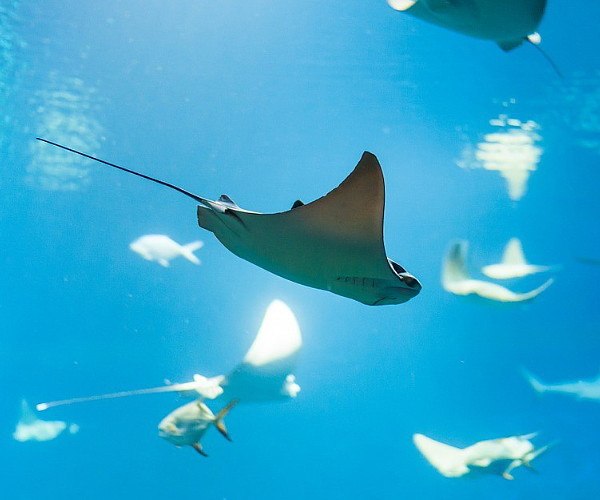 This species’ flattened bodies, as well as their black and with white spots, are what makes this species so attractive. Divers find them mostly near the coast and reefs since they feed on small fish and plankton. It’s said that this mysterious species of giant manta rays, which can also be seen off the Mexican coasts of Nayarit or Jalisco, are very intelligent. They are even said to exhibit a certain degree of empathy with divers. When they feel the bubbles coming from the oxygen tanks, they become more at ease and act “friendlier” with their human visitors.
On dives in the Revillagigedo Archipelago, you can also see other large fish and animals such as sharks, dolphins, and humpback whales (especially from January to March). All this has earned the archipelago the distinction of being one of the best diving destinations on the planet. The best season is from November to May, as the weather is milder during this period.
Alfonso Tandazo is President and CEO at Surtrek Tour Operator. Surtrek Tour Operator is a well-established firm, specializing in custom-designed luxury tours in Ecuador, the Galapagos and throughout the rest of South America.
If you would like to be a guest blogger on A Luxury Travel Blog in order to raise your profile, please contact us.
This species’ flattened bodies, as well as their black and with white spots, are what makes this species so attractive. Divers find them mostly near the coast and reefs since they feed on small fish and plankton. It’s said that this mysterious species of giant manta rays, which can also be seen off the Mexican coasts of Nayarit or Jalisco, are very intelligent. They are even said to exhibit a certain degree of empathy with divers. When they feel the bubbles coming from the oxygen tanks, they become more at ease and act “friendlier” with their human visitors.
On dives in the Revillagigedo Archipelago, you can also see other large fish and animals such as sharks, dolphins, and humpback whales (especially from January to March). All this has earned the archipelago the distinction of being one of the best diving destinations on the planet. The best season is from November to May, as the weather is milder during this period.
Alfonso Tandazo is President and CEO at Surtrek Tour Operator. Surtrek Tour Operator is a well-established firm, specializing in custom-designed luxury tours in Ecuador, the Galapagos and throughout the rest of South America.
If you would like to be a guest blogger on A Luxury Travel Blog in order to raise your profile, please contact us.Did you enjoy this article?
Receive similar content direct to your inbox.



Costa Rica has lots of manta rays at Cocos Islands and mainland at Catalina Islands where they school from Nov, through March.
Wow Ayangue just made it to the top of my holiday list!
I’ve never seen one in person but they do look like such amazing creatures. Can’t they grow past 20ft in length? I’m not sure what the average size is. I hadn’t realised they could be so huge until a few years ago; the size makes them seem daunting, yet they can be so slow and elegant in their movements. They make me think of bats when you see photos from above of them, as though their wings are out. It does seem like the best places are the ones like you’ve listed with clear waters, like Ayangue. A diving tour would be brilliant, would definitely want a dive-proof camera for that. I never thought of Hawaii being a place to spot them, not sure why. Nighttime diving, that must be incredible.
I have always wanted to go diving, and my husband and I will be in Hawaii next month. As you mentioned, this is a great place to see the rays up close. I suffer from claustrophobia, and I wonder if this will cause me problems while diving. Do you know if this is an issue, or if there are any ways to overcome it?